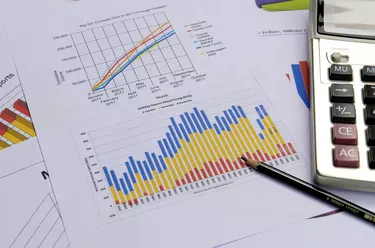
If you subtract the balance of a car loan from the fair market value of the car, what you have left is your equity in the vehicle. Book value or intrinsic value for a company is pretty much the same thing – it's the dollar value of the firm after you subtract debts from the value of assets the business owns. This is useful information because you can compare book value to the company's stock price and gain some insight into whether the business is overvalued or undervalued.
Book Value and Market Cap
Video of the Day
Suppose a company decides to liquidate. It sells off its assets, pays off its creditors and distributes the remaining money to shareholders. The money shareholders would get if this happened is the company's book value.
Video of the Day
Don't confuse book value with market value or market capitalization. Market capitalization is what investors are willing to pay for the company. Called market cap for short, it equals the price per share multiplied by the number of outstanding shares.
Book value and market cap can be different. For instance, a young firm with bright prospects for growth may have a market cap much greater than its book value.
The Formula for Book Value
You can find the necessary information to calculate book value on a company's balance sheet, found in its annual report. Part of the calculation is already done for you.
On the balance sheet, you'll see assets listed first and totaled. Next, the balance sheet states the company's liabilities. The last section lists shareholders' equity, which equals assets minus liabilities. To compute book value, subtract the dollar value of preferred stock from shareholders' equity.
Suppose a firm has $100 million in assets and $60 million in debts. Subtracting out, you get a shareholders' equity of $40 million. The firm issued $5 million in preferred stock, so subtract this amount, leaving a book value of $35 million.
Book Value per Share
It can be useful to compare the market price of shares to the book value. To make this easier, convert total book value to book value per share. Suppose a company has a book value of $35 million and there are 1.4 million common shares outstanding. Divide $35 million by 1.4 million shares for a book value per share of $25.
Tangible Book Value
Business assets can be divided into two categories: tangible and intangible. Tangible assets are the property a business owns, such as real estate, equipment, inventory and cash. Intangible assets include things like goodwill, the value of brand names and patents. These may be very valuable, but there's no physical property you can put your hands on.
A conservative approach to evaluating a company's worth is to calculate tangible book value, also called net tangible assets. The formula is the company's assets minus liabilities, intangible assets and the value of preferred stock. The result tells you what the tangible worth equals after liabilities are subtracted from tangible assets.